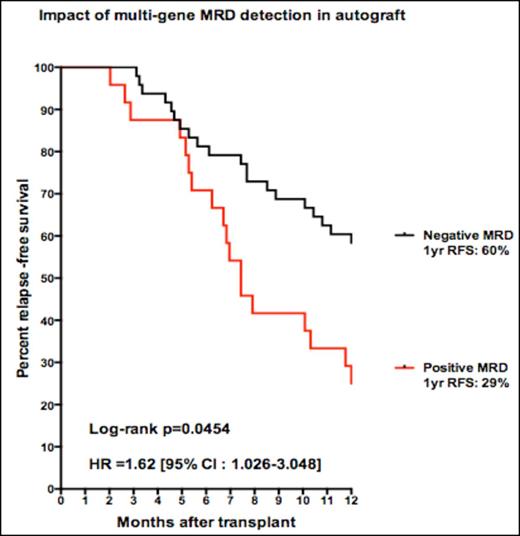Abstract

While commonly used in other hematological malignancies, high dose chemotherapy followed by autologous hematopoietic cell transplantation (auto-HCT) has not been widely adopted in acute myeloid leukemia (AML) due to concerns regarding high post-transplant relapse rates. These relapses may be due, in part, to autograft contamination with AML. High sensitivity methods to detect residual AML have demonstrated the ability to correctly identify patients in morphological complete remission (CR) at risk of relapse. We sought to determine if testing of the graft prior to transplantation could predict post auto-HCT relapse. Prior studies investigating the utility of measurable residual disease (MRD) in auto-HCT have been limited by small patient cohorts and/or by the use of a single biomarker to detect AML, a heterogeneous cancer. We report here the largest retrospective study to date of adult auto-HCT AML patients tested for measurable residual disease (MRD) by both molecular methods (RQ-PCR) and multi-parameter flow cytometry (MPFC).
Seventy-two patients transplanted between 2004-2013 at a single academic medical center (UCSF) were eligible for this study based on availability of cryopreserved GCSF mobilized autologous peripheral blood progenitor cell (PBPCs) specimens. All samples were collected on IRB approved research protocols.
The median age at time of transplant was 48 (24-69), 54% were female, cytogenetics were known in 94% (of which 24% were favorable, 69% intermediate, 7% poor), 99% were in CR at the time of HCT (64/72 in CR1, 6 in CR2, 1 in CR3). Following auto-HCT 1 year RFS was 50% (1 year relapse rate 43%) and 2 year RFS was 40% (2 year relapse rate 47%).
Wilms tumor 1 (WT1) is expressed in up to 90% of AML, but sufficiently over-expressed in peripheral blood to have utility as a sensitive marker of MRD in less than 50% of cases. RQ-PCR detectable WT1 above the previously established European LeukemiaNet threshold was found in 9 patients, of whom 6 relapsed in the first year after auto-HCT (19% sensitivity, 93% specificity, PPV: 67%, NPV: 60%).
We have previously reported that multi-gene testing can augment WT1 based MRD detection in AML. We were unable however to use one component of our previously reported AML MRD panel, PR3, due to increased baseline expression in these GCSF stimulated PBPC products. Increased PR3 expression following GCSF administration, correlating with neutrophilia, was also observed in an independent cohort of healthy donors.
Testing for PRAME, MSLN, CCNA1, t(8,21), Inv16, t(15:17) and NPM1 mutations A, B and D, as a supplement for WT1, in pre-HCT PBPCs resulted in substantially improved ability to predict post auto-HCT relapse (52% sensitivity, 80% specificity, PPV: 67%, NPV: 69%). Addition of these extra genes allowed for correct identification of 10 additional MRD+ patients who relapsed within 1yr after transplant, and added 5 false positive patients (1 of whom suffered early non-relapse mortality, and another who did relapse but more than 1 year after HCT).
Finally, in expert hands, flow cytometry can identify residual AML with high sensitivity. Forty PBPC samples from the above cohort were also assessed for MRD using MPFC. CD34 positive cells comprised 0.05-12.5% of autograft specimen mononuclear cells. Due to immunophenotypic changes likely attributable to GCSF mobilization, and without leukemia associated immunophenotypes from diagnosis available, MPFC was unable to identify MRD in any of 40 patients tested.
In summary, no single MRD test on autografts could completely predict post-HCT AML relapse. Auto-HCT presents unique challenges for AML MRD testing due to masking effects of GCSF on MPFC and RQ-PCR gene expression signatures. Additionally, detection of any AML autograft contamination must be extremely sensitive to be useful for predicting relapse given the absence of any potentially protective graft versus leukemia effect following an auto-HCT. Here we show combinations of molecular MRD assays can overcome some, but not all, of these limitations (Figure).
Radich:Incyte: Consultancy; Ariad: Consultancy; Novartis: Consultancy; Novartis: Other: Lab Contract. Andreadis:Cellerant: Consultancy; Novartis: Consultancy; McGraw Hill: Other: Publishers; Pharmacyclics: Honoraria. Damon:Sunesis: Research Funding; McGraw Hill: Other: Chapter Royalties; Atara: Consultancy; Sigms Tau: Research Funding. Logan:Jazz Pharmaceuticals: Consultancy; Amgen: Consultancy; Pharmacyclics: Consultancy. Martin:Sanofi: Consultancy.
Author notes
Asterisk with author names denotes non-ASH members.

This icon denotes a clinically relevant abstract


This feature is available to Subscribers Only
Sign In or Create an Account Close Modal